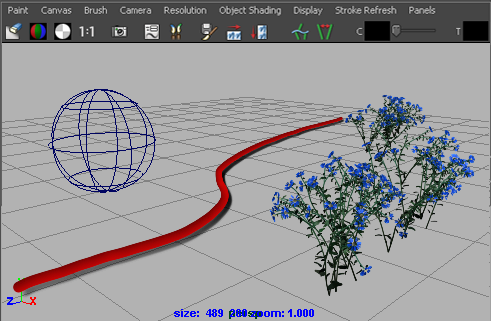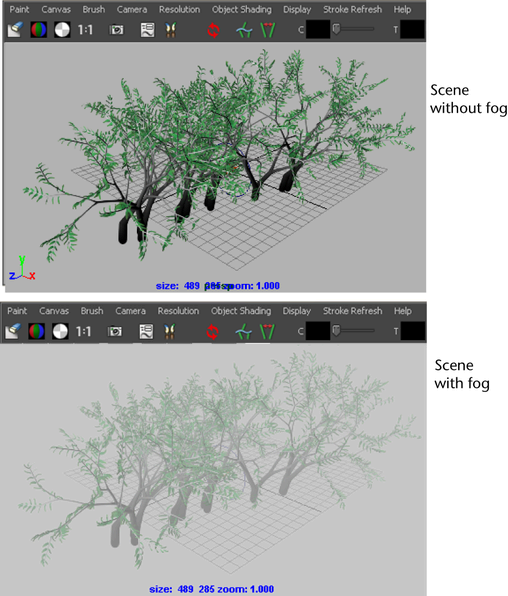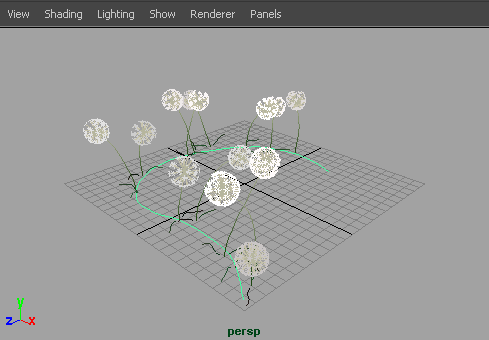When you drag in a scene
with the Paint Effects Tool, Paint
Effects creates a curve and attaches a stroke and new
brush to it which define the appearance and behavior of the paint
applied along the stroke path.
Whether you paint in
the scene view or the scene painting view, you can paint strokes
on the grid plane of the perspective view, directly on objects, and
on the view plane.
Paint in the scene view
When you paint in the
scene view, simple strokes display as curves. Strokes with tubes
display as wireframe representations of the rendered stroke. Paint is
not applied to the strokes until you do a post-process render, which
makes painting in the scene view very quick. It provides immediate
feedback in enough detail to see what you’re doing. To improve redraw
speed, you can adjust the display quality of the wireframe strokes,
just as you can adjust the display quality of objects displayed
as wireframe.
Paint in the scene view
when speed is an issue, but the final appearance of the strokes
is not (for example, when you want to move strokes, or when you are
painting many strokes with the same brush).
NotePainting in orthogonal
views gives unexpected results. Paint in the Perspective view
instead.
Render strokes as you paint
To
preview the rendered look of the strokes as you paint, click on
the Draw As Mesh option in the Paint
Effects panel.
Alternatively, you can
render the strokes as you paint them in the Paint Effects scene
painting view. The scene painting view is a snapshot
of the scene view. You can zoom, tumble, track, and dolly this view,
and the scene painting view will update accordingly. You can render
all the Paint Effects strokes or render
them individually (no other objects in the scene render).
Paint in the scene painting
view when you need to see what the strokes look like, but you don’t
want to do a final render (for example, when you are defining new
brush presets). You cannot use the transform tools, or any modeling
tools in this view. Although you can select objects in the scene
painting view and transform them in the Attribute Editor or Channel
Box, it is best to use the scene view for non-painting
tasks.
To display the scene painting view
- On the view menu bar, select Panels
> Panel > Paint Effects to open the Paint
Effects panel. The Paint Effects Tool is
automatically selected.
- Select Paint > Paint Scene.
The Paint Effects scene painting
view displays.
For information on changing
the display resolution of the scene and displaying the RGB display,
alpha, and luminance planes, see
Painting in the Paint Effects Panel.
These features are common to both canvas and scene modes of the Paint
Effects panel.
Refresh the scene painting
view
Zooming,
tumbling, tracking, or dollying the scene painting view takes a new
snapshot of your scene, rendering strokes according to the options
you select on the Stroke Refresh menu. These
options include:
- Off
-
Strokes display as wireframe
at their display quality when you zoom, tumble, track, or dolly the
view.
- Wireframe
-
Strokes
display as wireframe at 100% display quality when you zoom, tumble,
track, or dolly the view.
- Rendered
-
All strokes render when you zoom, tumble, track,
or dolly the view.
- Selected Only
-
Only selected strokes render when you zoom, tumble,
track, or dolly the view. Unselected strokes display as Wireframe (100%
display quality).
To render all strokes in the scene
- Do one of the following:
- Click the Redraw button
on the toolbar.

- Select Stroke Refresh >
Rendered.
TipIf you have complex
strokes in the scene that are taking a long time to redraw, press
the Esc key on your keyboard to stop the redraw.
Change the scene painting
view camera
By default, the scene painting view uses
the perspective camera (persp). Just like you can change the camera
in the scene view, you can change the camera for the scene painting
view.
To change the scene painting view camera
- From the Camera menu,
select the camera name (persp, front, side, top). Changing the camera
causes the view to redraw (the strokes are rerendered).
To change the camera
for the scene view, you select a camera from the Panels >
Orthographic submenu.
NoteIn this release of Paint
Effects, only the perspective view (persp) produces predictable
results.
Change the resolution of
the scene painting view
Because the scene painting view is a snapshot
of the scene view, you can set its display resolution. With lower
resolutions, you will see pixelated effects, but the strokes will
render more quickly when you refresh the view.
To change the resolution
of the scene painting view, select the desired resolution from the Resolution menu.
The final render is not affected by these settings.
- Full
-
Fits the view to the
available space and displays it at maximum pixel size (no zoom).
- 75%, 50%, 25%, 15%
-
Displays the view at
the selected percentage of the full resolution, occupying the same
the screen area by increasing the zoom level.
- Actual Size
-
Displays the view at
its actual pixel size (no zoom). You can also use the 1:1 button
on the toolbar. 
Change object shading in
the scene painting view
Use the commands on the Object
Shading menu to change the shading of objects in the
scene painting view. These options include:
- Wireframe
-
Draws
edges for polygon meshes and isoparametric curves for surfaces.
This is the default shading quality.
- Shaded
-
Renders
all surfaces, meshes, and particles as smooth-shaded objects.
- Textured
-
Displays
a hardware rendition of the texture applied to a material shading
an object.
- Use Default Lighting
-
Surfaces
appear fully illuminated by the Paint Effects default
light.
- Use All Lights
-
Surfaces
appear illuminated by all lights in the scene.
- Display fog
-
In the
real world, the atmosphere contains fine particles (fog, smoke,
or dust). These particles affect the appearance of the atmosphere
and the appearance of objects in the atmosphere.
In Maya, you can simulate
the effect of atmospheric particles using environment fog. If you
use Physical Fog in your scene,
you can display it in the scene painting view to see how the Paint
Effects strokes look in a rendered fog environment. For
information on using Physical Fog, see the Shading guide.
To display fog in the scene
painting view
- Select Object Shading >
Display Fog.
Paint on the grid plane
of the perspective view
When you paint on
the grid of the perspective view, the stroke lies on that plane.
To paint on the grid plane of the perspective
view
- Select
Paint Effects > Paint on Paintable Objects.
- Ensure there are no paintable objects
in the scene. To do this, in the scene view, deselect all objects
by clicking anywhere on the scene that is not an object, then select
Paint Effects > Make Paintable.
- In the Visor (
Paint Effects > Get Brush),
or on a shelf, click the brush preset you want to paint with.
- Modify stroke settings, if necessary
(
Paint Effects > Paint Effects Tool >
 ). For
information on modifying stroke settings, see
Define default stroke settings.
). For
information on modifying stroke settings, see
Define default stroke settings.
- Modify brush attributes, if necessary
(
Paint Effects > Template Brush Settings,
or use the Ctrl-b (Linux and Windows) or Control-b (Mac OS X) hotkey
combination. For information on modifying brush attributes, see
Define template brush settings.
TipYou can use hotkeys
on the canvas to interactively change the
Global Scale (set
ModifyUpperRadius, default hotkey, b), the
Brush
Width only (set ModifyLowerRadius), and
Stroke
Offset (set ModifyDisplacement, default hotkey, m) under
Brush
Tools in the
Hotkey Editor.
For information on other
Paint Effects hotkeys,
see
Use default Paint Effects hotkeys.
- In either the scene view or the scene
painting view, drag across the plane.
For information on the
scene painting view, see
Render strokes as you paint.
For information on working in the scene painting view, see
Automatically paint multiple strokes on a surface.
Paint on objects
To
paint on NURBS or polygonal objects, you must first make the objects paintable.
When you paint directly on a paintable object, Paint
Effects creates a curve on the surface along the stroke
path and attaches the stroke and new brush to it. When you translate
the object, the stroke moves with it. You can offset the brush from
the surface.
As you paint, the stroke
does not leave the surface unless you paint over another object
that is paintable. If you do paint across another paintable object
during the stroke, the stroke will continue on the other object,
bridging the two objects.
NoteYou can only paint
on NURBS or polygonal objects.
Note
- Because
the stroke attempts to stay on the surface, the result may be unexpected.
For example, suppose you have a sphere intersecting a plane. If you
start painting on the sphere, once the brush leaves the sphere,
it looks for another surface to continue on, the plane in this case.
However, if you start to paint on the plane, the brush never leaves
the surface, so the stroke doesn’t continue on the sphere.
- When you paint across the joined edges
of a surface (for example, the center line on a face created by
duplicating half the face and attaching it to the first half), your
brush stroke may appear to “leak” through the join. To remedy this,
make the surface periodic in U and V.
- Duplicating objects with strokes does
not duplicate the strokes.
To paint on objects
- Select the NURBS or polygonal object(s)
you want to paint on. If you are in the scene painting view, Ctrl-click
(Windows and Linux) or Control-click (Mac OS X) on an object to
select it.
- Select
Paint Effects > Make Paintable.
Note
- When you select Make
Paintable, only the currently selected objects are paintable.
Any objects previously made paintable become unpaintable.
- When you save and retrieve the scene,
any paintable objects become unpaintable. To paint on these objects,
you must make them paintable again after retrieving.
- Select
Paint Effects > Paint on Paintable Objects.
NoteIf there are no paintable
objects in the scene, your strokes will lie on the grid plane of
the perspective view.
- In the Visor (
Paint Effects > Get Brush),
or on a shelf, click the brush preset you want to paint with.
- Modify stroke settings, if necessary
(
Paint Effects > Paint Effects Tool >
 ). For
information on modifying stroke settings, see
Define default stroke settings.
). For
information on modifying stroke settings, see
Define default stroke settings.
- Modify brush attributes, if necessary
(
Paint Effects > Template Brush Settings).
For information on modifying brush attributes, see
Define template brush settings.
Tip
- You can use hotkeys on the canvas to
interactively change the Global Scale (set
ModifyUpperRadius, default hotkey, b), the Brush
Width only (set ModifyLowerRadius), and Stroke
Offset (set ModifyDisplacement, default hotkey, m) under Brush
Tools in the Hotkey Editor.
For information on other Paint Effects hotkeys,
see
Use default Paint Effects hotkeys.
- You can set a hotkey to reverse the surface
normal when you paint strokes on mirrored surfaces. For details,
see
Reverse surface normals.
- In either the scene view or the scene
painting view, drag across the plane.
For information on the
scene painting view, see
Render strokes as you paint.
For information on working in the scene painting view, see
Automatically paint multiple strokes on a surface.
TipTo paint on the grid
plane of the perspective view after painting on objects, in the
scene view, deselect all objects by clicking anywhere on the scene
that is not an object, then select
Paint Effects > Make Paintable.
Paint on the view plane
The view plane is the plane ortho-normal to the
camera. You can think of painting on the view plane as painting
on a sheet of glass that is facing the camera and fixed to it. When
you change the view (for example, when you tumble), the view plane
changes (the sheet of glass moves with the camera).
You can only paint on
the view plane in the scene painting view—not the scene
view. When you paint on the view plane in the scene painting view, each
stroke renders on the view plane, as you would expect. However,
the wireframe representation of each stroke displays between 0 and
1 in world space on the XY plane (near the origin). Although the
wireframe representation of the strokes appear to overlap in this
area, the rendered strokes display where you painted them.
NotePainting on the view
plane while in the scene view gives unexpected results. Use the Paint
Effects panel to paint on the view plane instead.
To paint on the view plane
- Select
Paint Effects > Paint on View Plane.
- Open the Paint Effects panel
(Panels > Panel > Paint Effects)
and switch to the scene painting view (Paint > Paint Scene).
- In the Visor (
Paint Effects > Get Brush),
or on a shelf, click the brush preset you want to paint with.
- Modify stroke settings, if necessary
(
Paint Effects > Paint Effects Tool >
 ). For
information on modifying stroke settings, see
Define default stroke settings.
). For
information on modifying stroke settings, see
Define default stroke settings.
- Modify brush attributes, if necessary
(
Paint Effects > Template Brush Settings,
or use the Ctrl-b (Linux and Windows) or Control-b (Mac OS X) hotkey
combination). For information on modifying brush attributes, see
Define template brush settings.
TipYou can use hotkeys
on the canvas to interactively change the
Global Scale (set
ModifyUpperRadius, default hotkey, b), the
Brush
Width only (set ModifyLowerRadius), and
Stroke
Offset (set ModifyDisplacement, default hotkey, m) under
Brush
Tools in the
Hotkey Editor.
For information on other
Paint Effects hotkeys,
see
Use default Paint Effects hotkeys.
- Drag across the plane.
For information on working
in the scene painting view, see
Automatically paint multiple strokes on a surface.
NoteYour stroke renders
on the view plane, however, the wireframe representation of the
stroke appears on the XY plane between 0 and 1 in world space. To
see this press the Alt (Linux and Windows) or Option (Mac OS X) key
on your keyboard.
Reverse surface normals
When you paint a stroke on a paintable
object, the tube growth is relative to the surface normal. You may
find yourself painting on surfaces with reversed normals (for example,
if you are painting on a model where one side is a mirror of the
other), in which case the tubes will grow in the opposite direction.
To remedy this, switch
the Opposite flag for the surface before you
paint on it (turn it on or off). Switching the flag for the surface
after painting a stroke will have no effect on the existing stroke.
To switch the Opposite flag
- Create a hotkey for Toggle
Opposite Flag of Selected Shapes (select
Window > Settings/Preferences > Hotkey Editor then
click the Paint Effects category). For
details on creating hotkeys, see the Basics guide.
- Select the surface.
- Press the hotkey to switch the flag.





 ). For
information on modifying stroke settings, see
Define default stroke settings.
). For
information on modifying stroke settings, see
Define default stroke settings.



 ). For
information on modifying stroke settings, see
Define default stroke settings.
). For
information on modifying stroke settings, see
Define default stroke settings.


 ). For
information on modifying stroke settings, see
Define default stroke settings.
). For
information on modifying stroke settings, see
Define default stroke settings.
